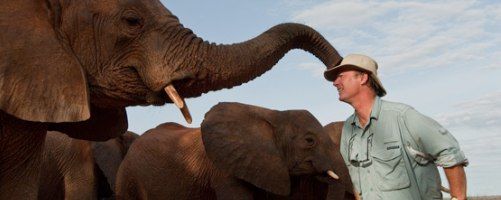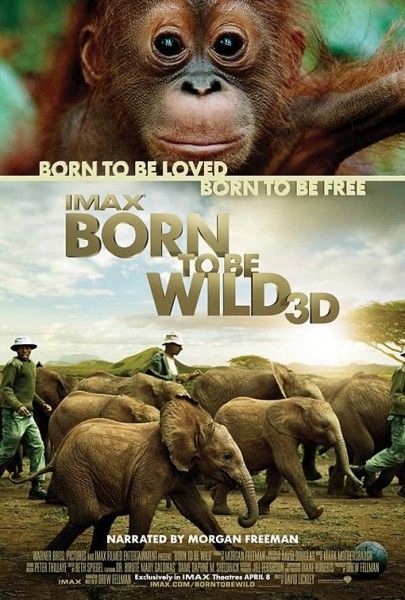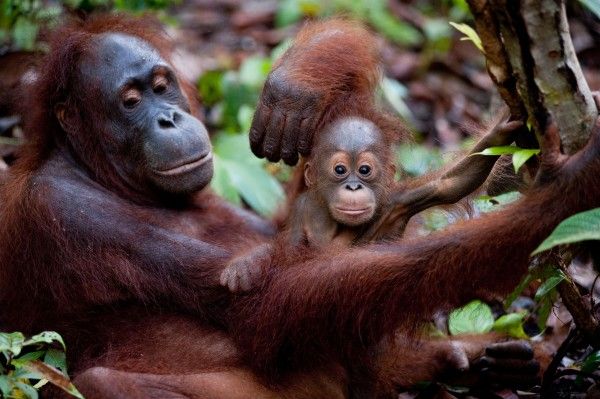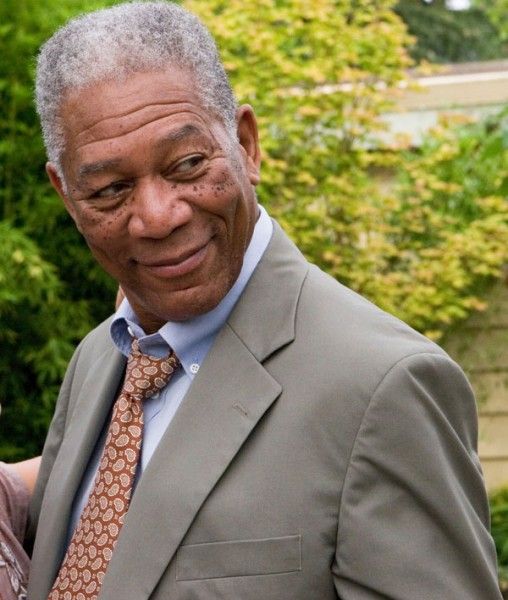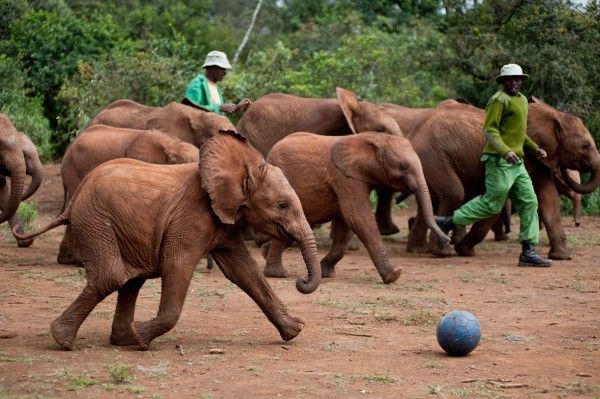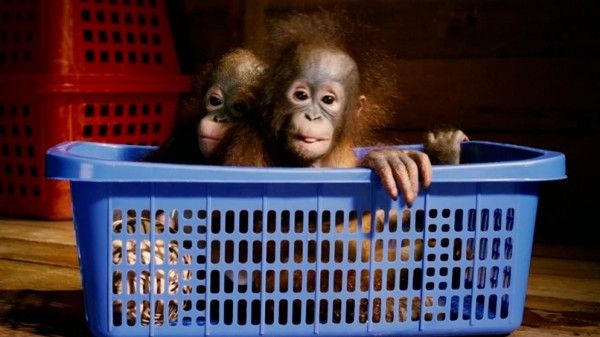The documentary adventure Born to Be Wild 3D illustrates the remarkable bond between humans and animals, and the love and dedication they have for each other. The IMAX 3D format allowed director David Lickley to transport moviegoers into both the rainforests of Borneo, with world-renowned primatologist Dr. Biruté Mary Galdikas and her orangutans, and across the Kenyan savannah, with celebrated elephant authority Dr. Dame Daphne M. Sheldrick and her elephants, as they and their teams rescue, rehabilitate and return these incredible animals back to the wild.
In this recent exclusive phone interview with Collider, David Lickley talked about why he’s an animal person, his 20 years of working on wildlife-related film projects, why these orphaned animals were such a heartwarming subject, using 3D to immerse the audience in the experience, why it’s so important for people to be more aware of the natural world and what they can do to preserve it, and why he wants to focus on China and the giant panda for his next IMAX project. Check out what he had to say after the jump:
Question: How did you get involved with Born to Be Wild for IMAX 3D?
DAVID LICKLEY: This project originated with the producer, Drew Fellman, who had been to Borneo and seen the orangutan situation over there, just as a tourist, and thought, at the time, that it would be a really good IMAX project. He brought it to IMAX and Warner Bros., and once they got going, they came to me and said, “Would you like to direct it?” This is my fourth IMAX wildlife film. So, I said, “Sure!” It’s a perfect film for what I like to do, in terms of getting these stories across. It was an opportunity that came, that I thought was great.
Have you always been interested in animals and their behavior, and how they interact with humans?
LICKLEY: Yeah. I have a Master’s degree in biology. I studied animal behavior in grad school. I’ve been working on wildlife-related film projects for 20 years. I’ve done four IMAX film projects that relate to animals. In IMAX, I’ve worked with Jane Goodall and chimpanzees, I’ve worked with bears, I’ve worked with the return of the lake sturgeon to the Great Lakes. I’m an animal person. That’s what I study and that’s what I like to tell the stories of, and especially the people that are involved with these animals, who really are at the front lines of saving these kinds of species.
What was it about these orphaned animals that you thought would make for an interesting story to show people?
LICKLEY: There are two things about it. When you’re in these orphanages, you see these animals and you pick them up, and you see the way the caregivers work with them. It’s heart-rending, on many levels. You identify with them, when you go there. You go, “Oh, my god, this is an amazing story and an amazing animal.” But, beyond that, the two characters – Daphne Sheldrick and Birute Galdikas – pioneered this whole orphanage concept with elephants and orangutans, and have spent 40 plus years, out there in the wild, trying to make this work. These are pioneers and legends, really. Having the privilege of telling their stories is what makes this film work. Profile is all-important when you’re trying to keep things, like organizations, going that are out there in the wildlife sector. Birute’s work is one of those untold stories. She was one of the three ape angels that were sent out by Louis Leakey, back in the 1960's and 1970's, to study apes. He felt that you could learn a lot from ape studies, in terms of his anthropological work, so he sent Jane Goodall to study chimps, he sent Dian Fossey to study gorillas, and he sent Birute Galdikas to study orangutans. Those other two stories have been fairly well told. Jane has a huge profile. I’ve already worked with her on one IMAX film. But, with Birute’s work, it’s harder to film the orangutans than it is to film the chimps and the gorillas. She toiled in these jungles of Indonesia, following through on what Louis sent her to do, which was to understand orangutans. Then, that morphed for her beyond just understanding into trying to do something and taking on the role of caregiver, and starting up her orphanage and getting these animals back to the wild. That’s what she’s all about. The most important factor in all of that is the habitat. She is trying to save the habitat in which these animals live because, without the habitat, there will not be wild orangutans.
What are the biggest challenges of shooting in these remote places, and approaching it so that you don’t become too intrusive with the cameras?
LICKLEY: Our cameras are impossible not to be intrusive with. It’s an IMAX 3D system. The film camera weighs 300 pounds. The new digital version that David Douglas, the DoP, built with IMAX is a silent 100 pound version, but it’s still not small, and it takes two or three people just to manage the camera system. You’re not stealth shooting, so you’ve got to pick a subject matter that really is not going to be too intimidated by the fact that they’ve got this camera in front of them when you’re filming. These animals were perfect because they are orphans or ex-orphans, so they’re used to people. They’re not going to run away when you get in there. And, they’re fairly patient. They let you set up for a day or two and, when they want to do something, they’ll do it. If you’re in the right area and they’re there, they ignore you after awhile because they’re used to seeing people. We’re not stealth-shooting. It’s not BBC, going off into the wilds and hiding out in the forest for a month, hoping to see something. Our format would never work that way. You just can’t get the footage. We picked the right animals to work with, for sure.
Since animals are notoriously unpredictable and you obviously can’t control what you get from them, do you have to approach a film like this knowing that you’ll never know exactly what you’ll get?
LICKLEY: Oh, absolutely. There’s a basic story that we wanted to tell, from the very beginning, and that was how these animals come to be in the nurseries, what it’s like to be in the nursery, and how you get them back to the wild. You have a natural story arc, to begin with, but within that, what happens is totally random. The nurseries are slightly more controllable. When they’re really young, they take them to places and let them play, so you can pretty much get what you want in there. But, as soon as you move out into the second stage, which for orangutans is basically the wild, they are ex-orphans that are now free and they’re out doing what they’re going to do. With elephants, you’re out in the middle of Tsavo National Park, in the forest, with a group of ex-orphan, large elephants as well as wild elephants that are out there and other animals. There’s a huge element of unpredictability that happens, as soon as you get away from these nurseries. You just need a lot of luck and a lot of patience, and the right equipment and crew, to get into those situations. You go out and you say, “Okay, we’re going to try this,” and you just hope it works. Not everything works, but you get enough stuff, at the end, to make our 40-minute film.
Being out in the wild like that, do you ever have moments where you feel like you’re in danger?
LICKLEY: They’re ex-orphans and there are keepers that are with you. You always have people around you that understand the situation. But, during the elephant shoot, we were on the scout of the film, going out with the ex-orphans, who were walking with keepers through the savannah. We were away from all the vehicles, but it’s the wild Africa. It’s the National Park and it’s massive, and there were all kinds of other animals, like lions, around us. So, we were out walking with the elephants and there was this herd of cape buffalo, which have these big, curved horns. They’re one of the most dangerous animals to encounter in the forest because they’re unpredictable and they’ll charge and they’ll gore you. So, the elephant keepers said to us, “Okay, get behind the elephants ‘cause they’ll protect us.” We all got behind the elephants, and then the elephants looked up, saw the cape buffalo and they freaked, and they stampeded through us to get to the other side of us because they thought we were the protection. So, we had a herd of elephants running through us and past us, to get to the other side. All of a sudden, we become the front line for these elephants. One of the guys got knocked over and his glasses were smashed. It’s just one of those chaotic things that happens when you’re out with wild animals. It made us realize, “Okay, there is a lot of unpredictability that we’re going to face when we actually bring these cameras out here.”
How does presenting this in IMAX 3D add to the visual presentation?
LICKLEY: To me, IMAX 3D is the next best thing to being there. If you get into an IMAX theater in 3D, you get immersed in the place, and that’s how you get it across best. You feel like you’re there with the animals, and with Daphne and Birute. At the end, you forget where you are, in a way. It’s not a little screen, where you’re looking around. It’s like you’re in the setting. There’s really no better way to tell a story like this and to have an impact than to put it up on a big IMAX 3D screen. It is the most impactful format that we have today.
How did Morgan Freeman get involved, and what does his narration add?
LICKLEY: He got involved because Warner Bros. and IMAX asked if he’d narrate the film, and he has a strong environmental/animal bent and ethic. It was a project that he could identify with, and he agreed to do it. He is the perfect narrator for this film. He’s warm, but he’s emotional, at times, when you need him to be. He can be funny. He’s the storyteller. He’s like the grandfather or father who is telling this story. It’s a perfect setting because these two ladies are like the grandmothers who you want to have looking after you and all the animals in the world, and then you have Morgan who tells their story in this warm, compassionate way. I can’t think of anybody better to deliver that narration than Morgan Freeman.
Were you surprised at how fragile an animal the size of an elephant is?
LICKLEY: Yeah! That’s startling. Orangutans are pretty resilient. You get them in the orphanage, you start feeding them, you’ve got humans around, they’re clinging to them, they get a lot of love and attention, and they seem to thrive in the orphanage setting. The elephants are a really different situation. They have a deep emotional connection with the herd and with their mothers, and when that’s broken, they’re traumatized. We look like the people that just killed their parents, so it’s like, “What’s happening here?” Daphne loses probably 30% of the elephants that come in. They just don’t make it through that first year. They come in too weak, too dehydrated, too sick or too emotionally disturbed, and they don’t make it. It breaks Daphne’s heart, every time she loses an elephant, because they’re her children. It did really surprise me. We had to be really careful when we were filming these orphans, that we didn’t disturb them too much. Even after a year or two in the nursery, they’re still somewhat fragile and they still lose them. We were really careful, how we worked around those animals. They form deep emotional bonds. Just like they do with the herds, they do it with the keepers, and then the other elephants around them. When they go to the wild, those ex-orphans that have been released before them become their new parents, in a way. They take them in. In a wildlife setting, it doesn’t happen often, where an animal that’s in the wild will take in an orphan. Most animals don’t accept orphans because they can’t manage them, they can’t feed them and it’s competition with their own children. Elephants are different. They have a very strong group social ethic and drive. They want to have these orphans with them. They take them under their wing and they become the new mothers. It’s really moving to see that happen.
Have you found that working with these different types of animals has really had an effect on you, and changed how you see things?
LICKLEY: Yeah. Every one of these animal projects I work on, you get to immerse yourself in their experiences and you come away as a champion of the animals. You love the animals, by the end. I understood more about the orangutans, when I started the project, ‘cause I had just finished doing a film with Jane Goodall on chimpanzees, in the IMAX format. I’d worked with one ape already, and I had a sense of what to expect with orangutans. My biggest surprise was the elephants. I looked at them and thought, “Okay, these are big, lumbering animals. They don’t have hands to grab you with. How attached will we really become?” But, you bond with these baby elephants. They come up to you and bump up against you. They want you to blow into their trunk because that’s how they actually know who you are. They pick up your scent. They’re always coming up and wanting affection from you. They’re just amazing! When they go out in the wild, they’re the same way. They’re this very strong, family-bonded animal. You just feel differently about elephants than you did before. The thought of somebody going out and poaching an animal like that just makes me crazy. I can’t imagine how you could do that. They’re wonderful animals. They’re smart, they’re intuitive, they understand things that we don’t understand, and we’ve got to do our best to keep them around.
Why do you think it’s so important for people to be more aware of the natural world around them?
LICKLEY: Can you think about a world that doesn’t have animals, like elephants and orangutans, in the wild? It’s not the same world. We’re given this planet as a gift, and it’s our job to steward it properly. We have the most power of any animal on the planet, and we have a responsibility to every other animal on this planet to look after things. I think people have to go through life, thinking about the impact that they have and what their lives do and how they can help everything else around them. It’s part of being aware. I just hope this film helps to do that, for the orangutans and elephants, and all the animals. I think there’s a spin-off from that to care about nature, period.
What do you think it is that makes someone want to devote their lifetime to caring for other species?
LICKLEY: It’s unfathomable to me. With what Birute went through, to get her study started, and to keep at it for 40 years, and Daphne too, it must be something where you go out there and become so close to these animals that they’re like your family, and who wouldn’t want to protect their family. The only explanation that I have for it is that they become as close to you as your own children, so you do everything in your power to protect them. That’s what they do. They’re devoted to these animals, and they would do anything to protect them. These are really amazing animals. If I could take everybody to Borneo and sit them down in that jungle for a day, with these animals, you would change how people think about them. But, we can’t, so the next best thing is to put you in a theater and say, “This is their world.” The best thing you can do right now, as a person, is to adopt one of those animals. Go to the organizations, like Orangutan Foundation International at www.orangutan.org or the Sheldrick Wildlife Trust at www.sheldrickwildlifetrust.org, and become an adoptive parent. It doesn’t cost that much money, and you will be doing a huge amount of good, not just for the orphans, but for the people that are out doing poaching patrols and buying up the remaining habitat, so that there’s some place for these animals to go, when they go wild again.
Are you currently working on or developing your next film for IMAX?
LICKLEY: I’m actually looking at a couple of things. I’m trying to get a project on China, called Wild China: Land of the Panda, off the ground. China has 5% of the entire world’s bio-diversity and there are a whole bunch of things that are unique to China, including the giant panda, that are very interesting. So, I’m trying to do an IMAX 3D project on that. My current focus now is to get that project off the ground.
BORN TO BE WILD 3D opens in theaters on April 8th

